
One of the many amazing things about being here is that we are not only custodians of a mill, but of several millstones, some of which (the mill’s former custodian informed me) were found in nearby fields and were kindly returned to the mill by local farmers after the building’s restoration a few years ago.

As aesthetic objects, I find the millstones in themselves extraordinarily beautiful and appealing. . .

. . . but they are also objects with a history, about which (me being me) I’m now trying to find out more.
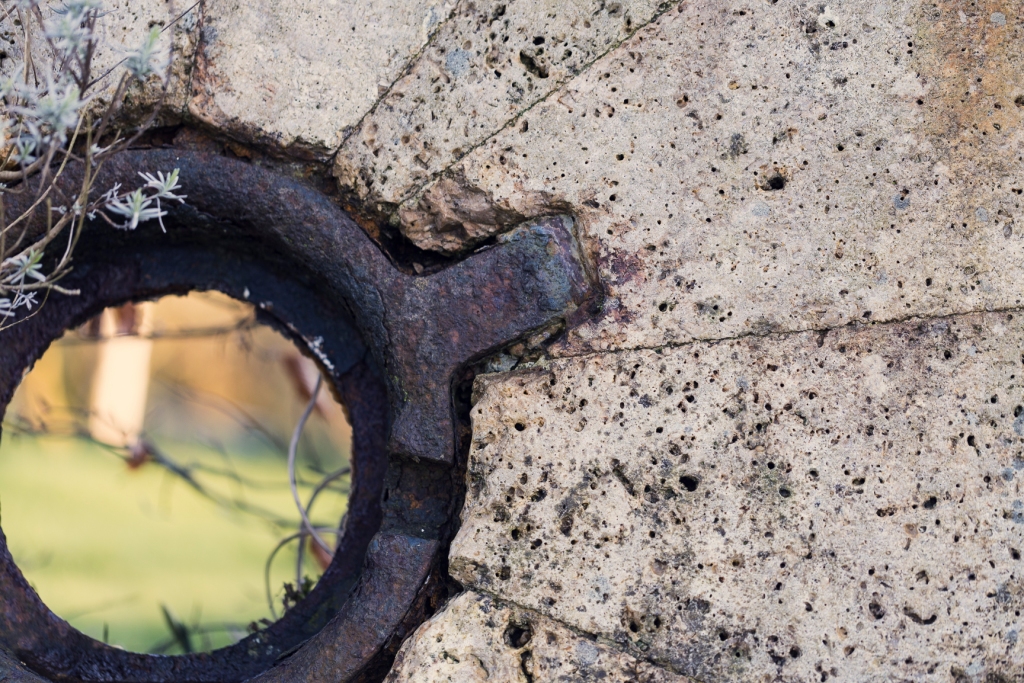
I began my reading with the always brilliant Angus Martin’s Kintyre Country Life (1987; 2014), which includes a tantalising anecdote from an unpublished manuscript by Andrew McKerral (author of Kintyre in the Seventeenth Century (1948)) about the bringing of a finished millstone from the quarry at the Brunerican shore (a mile or two away from us) back to this mill.

“After the stone had been finished, the miller got the tenants assembled to fetch it. Through the hole in the middle of the stone, a long pole — or wan [wand] — was inserted to which horses were yoked. The ends of the wan were “held and steered by some of the men” and in that way the stone was “trundled along the shore, across the Conieglen Water, and finally to the main road and the mill.”
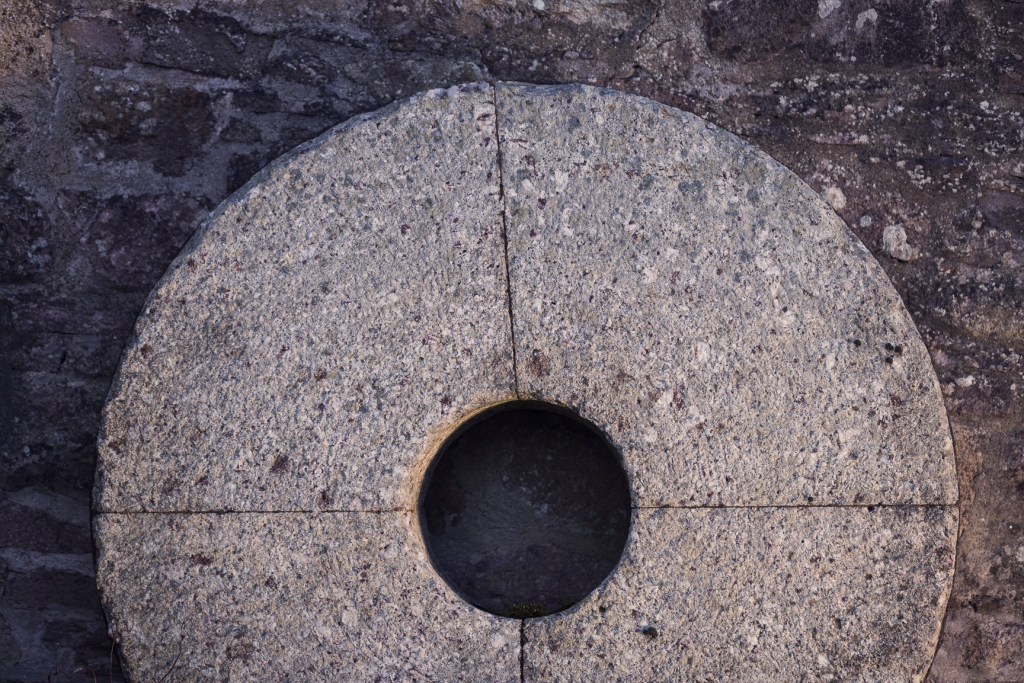
McKerral apparently noted that unfinished millstones could still be seen around Brunerican at his time of writing (1945). I have not spotted anything there that looks remotely like a millstone as yet, but Tom intends to get the drone out this weekend to see if aerial images might help us pinpoint the location of the quarry (here’s hoping!)

“Our” mill first appears in the Kintyre record in 1636, and the practice of rolling home locally quarried millstones with local folk, horses and “wans” seems to have been common all over Scotland in the seventeenth and early eighteenth centuries. Scottish millstones were quarried in one large, circular piece, and were not only rolled home, but exported, by sea, to England, Ireland and the then colonies in North America. In Kintyre as in other parts of Scotland, the quarrying and production of local millstones probably did not persist much beyond the early decades of the eighteenth century, because at that point (as Enid Gauldie explains in The Scottish Country Miller (1981)), Scotland began importing French millstones instead. French millers had discovered that grains ground against hard chalcedonic hornstone quartz — or burr stone — created meal and flour of exceptional quality and fineness. Burr stone was also incredibly hard and hard wearing (and therefore economical). English and Scottish millers wanted in on the French burr stone action!

Rather than being quarried in one large circle, writes Gauldie “French burr stones were quarried in small pieces which were trimmed to fit together in segments like those of the arch in a building. They were then stuck together with mortar or plaster of paris and an iron hoop was applied by coopers to the edge of the stone.”
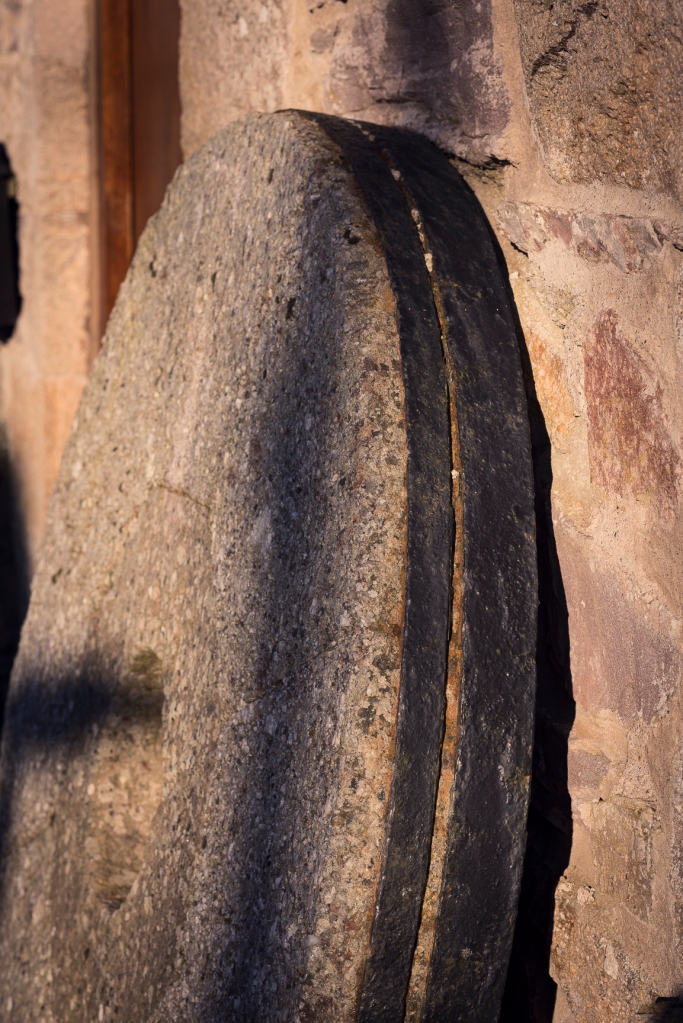
French burr stone became so important to British milling, that, as Gauldie writes: “in 1809, the embargo on trade with France had to be lifted for three months to allow their importation. It is surely an indication of their importance to the food supply of the nation that a war should be interrupted to allow them passage.”

“Our” millstones, then, are not seventeenth century originals, quarried in one piece from local conglomerate on the shores of Brunerican, but French burr stones, quarried in pieces, shipped to Scotland, reformed and secured with iron bands by local coopers, and subsequently locally dressed.
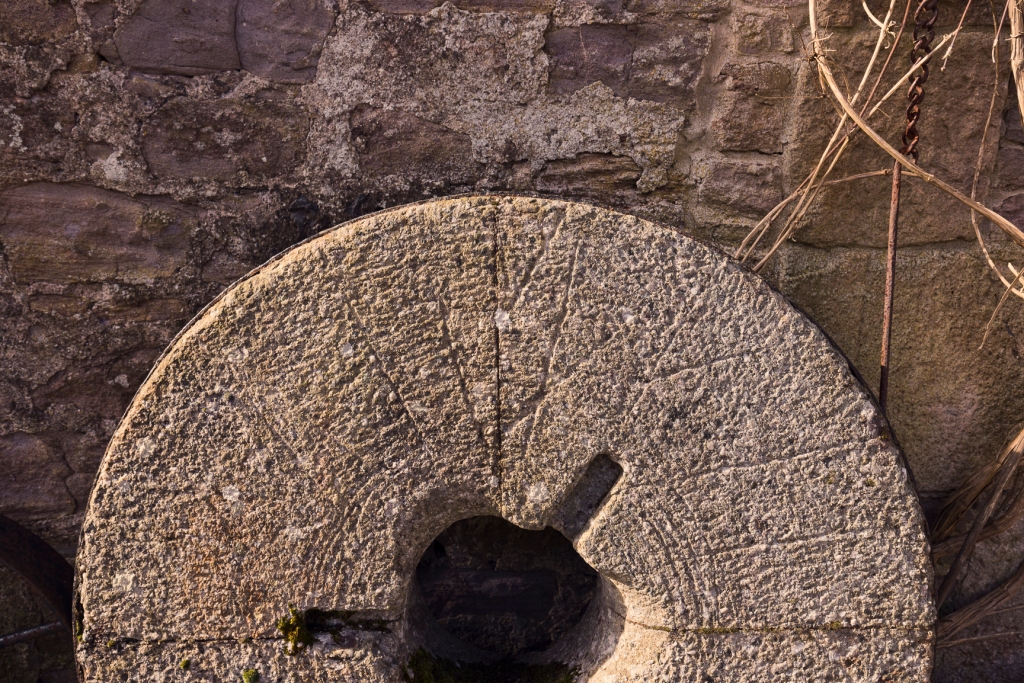
The worn grooves of the dressing are still evident on some of the stones.

But two of the stones are not formed from burr stone only. With different stone being used for their outer rings and inner hubs, they are in fact rather interesting composites.
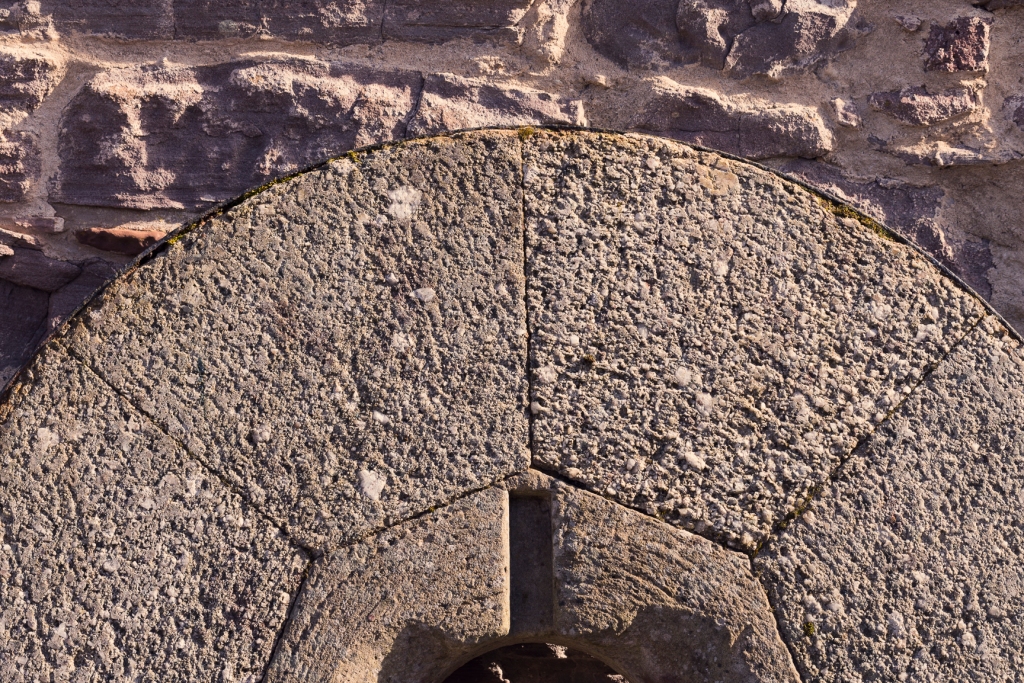
The outer ring of these stones are formed from 8 banded segments of French Burr, while their inner hubs have been quarried from single pieces of local sandstone

From comparing them to other examples illustrated in Geoffrey Hay and Geoffrey Stell’s Monuments of Industry (1986), I’d say the stone above appears to be an oatmeal runner stone and the one below an oatmeal shelling stone.
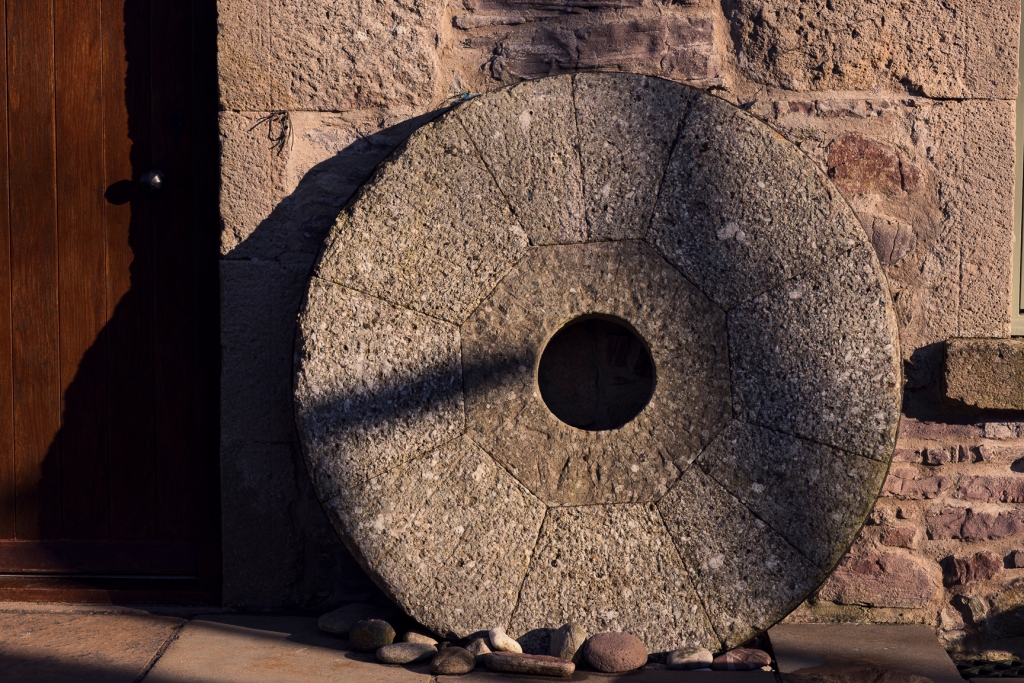
“The use of a sandstone centre in order to economise in the use of the expensive French burr stone was,” Hay and Stell note, “apparently a distinctive Scottish practice.”
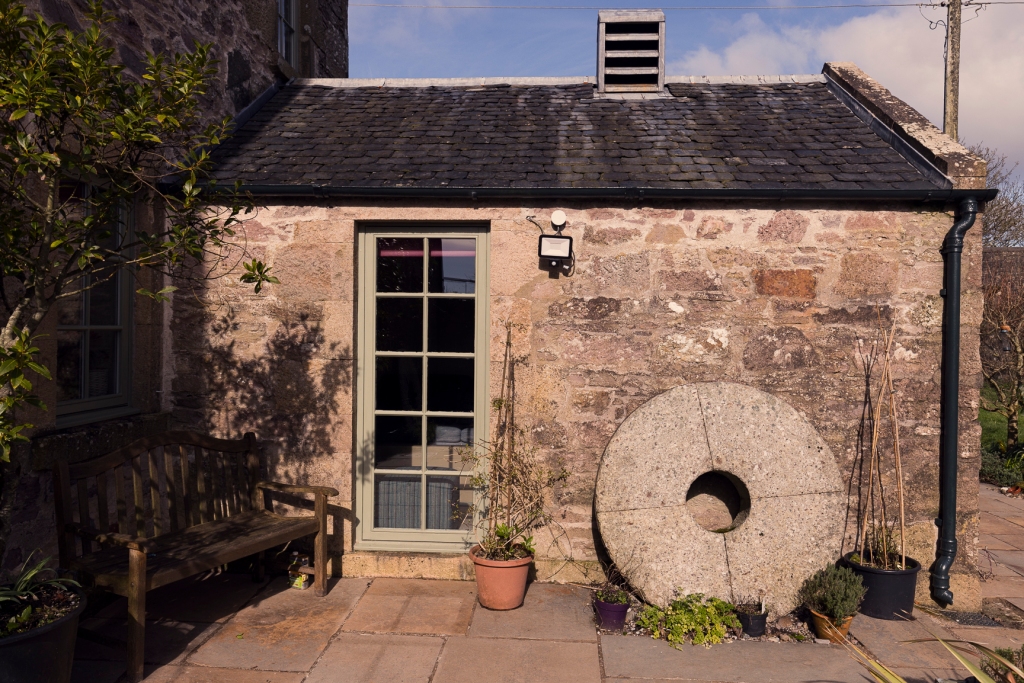
I’ve an awful lot to learn about the mill and its beautiful stones, but what I’ve been able to discover so far has already taught me something about the evolving life of this historic building: adopting new technologies, processes, tools, and stones as it tirelessly transformed grain into food for animals and humans over the course of four centuries. I also now understand a little more about the interconnectedness of a rural economy that extended from the shores of Kintyre to the quarries of La Ferté-sous-Jouarre.
Hope you don’t mind my sharing my millstone investigations. I shall, of course, be sure to tell you if we (and the drone) discern any evidence of millstone quarrying at Brunerican!
References:
Geoffrey Hay and Geoffrey Stell, Monuments of Industry (1986)
Andrew McKerral, Kintyre in the Seventeenth Century (1948)
Angus Martin, Kintyre Country Life (1984)
Enid Gauldie, The Scottish Country Miller (1981)

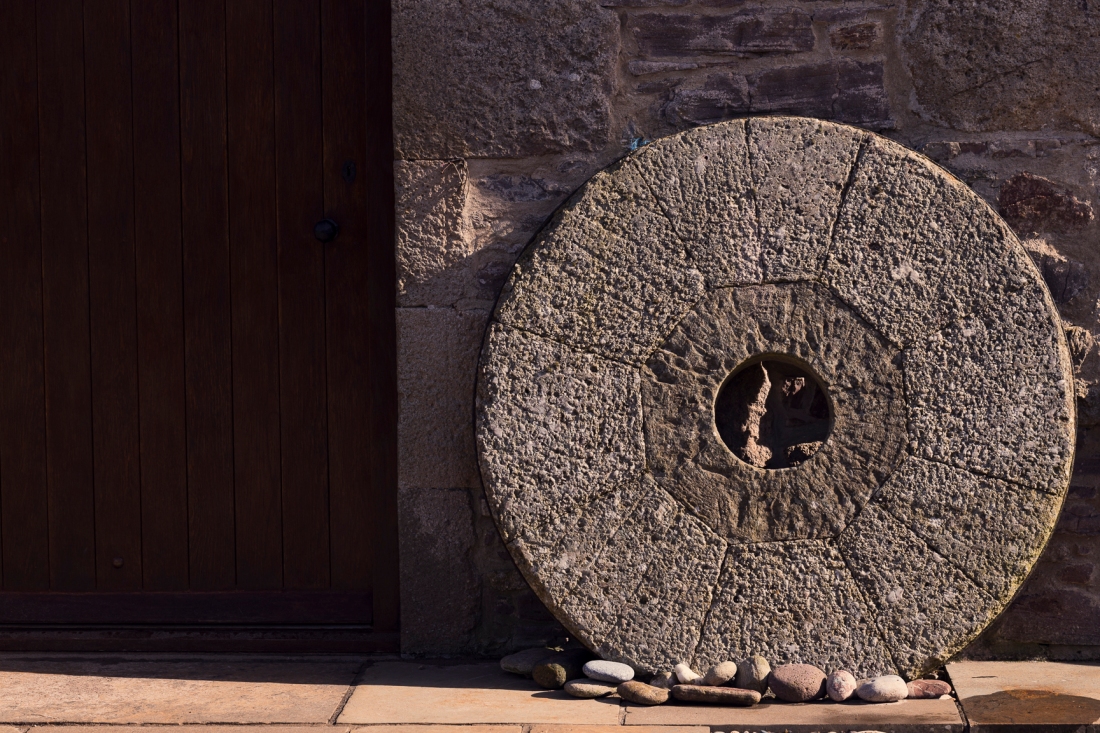
What a spectacular and fascinating post! And what a special place to call home. Thank you so much for sharing. I am now about to explore the references. This is absolutely FASCINATING! Such beautiful and functional pieces connecting to our lives and history.
LikeLiked by 1 person
I’m a little obsessed with *round objects* and putting them on hats and yokes and shawls and stuff, so this is all faskinating!
LikeLike
What a beautiful and fascinating site you now call home. Thank you for sharing your finds, physical and intellectual. As fortunate as you are to have become the owners of such a marvelous home, so the mill is to have come into your hands.
LikeLike
Thank you for sharing what you are learning about millstones! There is something about seeing the marks of dressing a stone, or the wearing of down of a useful object, that touch my heart. I love thinking about the time and care that it took for someone to make a millstone, fit it, the time it spent with a useful life of grinding grain for bread. It is all very earthy and fulfilling. Thank you!
LikeLiked by 1 person
I too am really interested in the social history and archaeology of a place.
I see someone mentioned Lidar.
Here is a link to a site that shows lidar scans of much of great Britain.
https://www.archiuk.com/cgi-bin/archi_new_search_engine.pl?search_location=NR%2070%2023&search_type=archi_town_search&pwd=&TownName=KINTYRE&county=Argyll%20and%20Bute&search_range=10000&period=&font_size=&placename=Kintyre&info2search4=archi_town_search&keywords=
It’s incomplete but more seems to be added from time to time. Our area was only added lately.
You can also show aerial photography and some old maps but others require you to pay a membership.
I shall keep checking!
LikeLiked by 1 person
Mind?! I love it, and all of your essays. Looking forward to the next one.
LikeLike
Thanks for the very interesting piece on the millstones. I am always interested in how people renovate commercial spaces into homes. Will you someday show us the inside of the mill and how it was modified into a home?
LikeLiked by 1 person
Thoroughly enjoying your info on the mill and surrounding areas!
LikeLike
I am so delighted to be on your mailing list. I love every essay you write. I hope someday you will share the interior of your new home. I am very curious!
LikeLiked by 2 people
I’m intrigued by how communities would so often use local materials rather than importing. There were so many examples in ship and house building. But your stones are very different. I would love to know if your stones were part of a return ballast ( like the pianos and slate in the grain and wool clippers from Australia) and if so what was Kintyre exporting to France?
LikeLiked by 1 person
How wonderful to read a bit more about the special millstones! I love them and it’s just JOY to read about your research and discoveries about the new place where you live. In Reading at the Museum of English Rural Life, there was a beautiful video showing the process by which a wooden cart wheel was made, with the spokes being hammered into a central hub, and then the outer wooden wheel being attached (can’t remember exactly how that part happened) and then an extremely hot iron hoop being removed from the Coopers’ furnace and applied to the outside of the wheel. The whole was plunged into cold water, to much bubbling and drama, causing the iron to sort of seize and shrink, cinching the wheel and spokes together. Is this the same method used to enclose the stone segments do you think? In other words, IS IRON STRONG ENOUGH TO CINCH STONES INTO PLACE?! I hadn’t contemplated this possibility until reading your post and looking at your super photos. How exciting to be living somewhere that has such a long local history; you just can’t argue with mills and grains and – most of all – the joy of millstones. I am reminded of a magic post you wrote years ago about Quernstones – the predecessor of this technology. Thanks for sharing such inspiring history with us always x
LikeLiked by 2 people
Can’t wait for the next installment. I will never look at a millstone the same way again,
LikeLike
Love all of this
LikeLiked by 1 person
As a geologist interested in folk crafts and deciphering interesting things in landscape, I couldn’t wish for a most interesting post! I’m sure you will be able to find the quarry in a digital surface model from LIDAR. I found some UK and Scotland datasets to download for free on data gov uk but the file sizes are too large for my computer, maybe you’ll be more lucky. My country has these maps available in an online viewer but it seems we are quite an exception!
LikeLiked by 1 person
I am hungry for more and more info on your old mill house as well as its wheels (and other wheels you may find lying about). And I’m excited to tell you my book (well, YOUR book) arrived here in Houston Texas today, and I can’t wait to share it with my local weaving guild at tomorrow’s meeting during Show and Tell! It’s beautiful!!
LikeLiked by 1 person
These millstones, with their lines and curves from iron bands and segmented parts ,will find a way into your knitting. Oh such wonders to be found. Always enjoy your discoveries Kate and Tom.
LikeLiked by 1 person
Kate, please share all and as often as you would like – don’t spare one discovery that you find interesting. Thanks so much for sharing this piece. I love these kinds of discoveries of history and development and to think you live in a place with such interesting and meaningful history! You must hear the walls speaking to a curious and wondering ear! May the unfolding continue in earnest.
And, oh the photos! What an eye! Thanks to Tom as well for providing the visual words.
LikeLiked by 1 person
Hi Kate,
I absolutely loved reading this article about your precious mill and its millstones. Thank you so much for sharing your learnings with us. I look forward to reading more! Your enthusiasm is so contagious.
Sadly, in my area of the world (US) just recently a local corm meal mill that had been grinding corn up until a couple of years ago was sold. The grinding apparatus dismantled.
Sincerely,
Lynn
LikeLiked by 1 person
Absolutely fascinating Kate. Do tell us more when you have it! Thank you.
LikeLiked by 1 person
Kate, your new home is beautiful and so are the mill stones. I love history also, so learning about the story behind the stones is great. Thank you for sharing!
LikeLiked by 1 person
Oh YES, another mystery solved :0 I loved the history of the millstones and how they were put together. How much do they weigh? Any information on that. Thank you for this post.
LikeLike
Absolutely fascinating – more please, when you have time – and, thank you for bringing to my recall a wonderful day at Kilmartin (my geography is hazy, is that near you?), where I was introduced to a quern and allowed to grind some grain 🙃
LikeLike
Your research always serves my brain well.
LikeLiked by 1 person